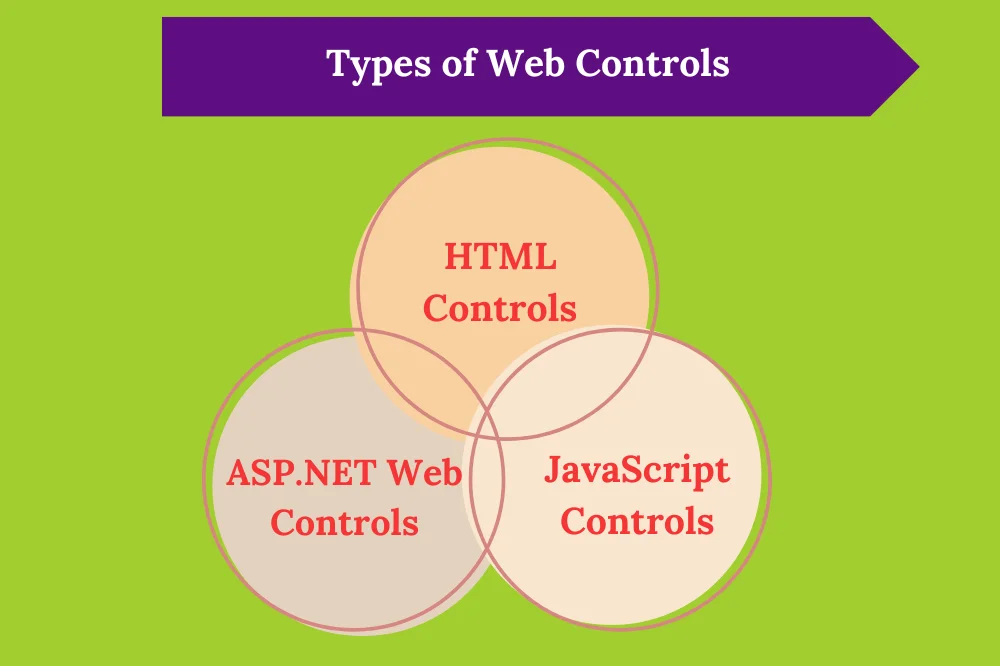Navigating the Web: A Guide to Different Web Controls

Navigating the Web: A Guide to Different Web Controls
Introduction:
Definition of Web Controls:
Web controls are interactive factors on a website that allow users to input statistics, interact with the web page, and carry out diverse moves. These controls can include easy HTML elements, superior ASP.NET server-aspect controls, and dynamic JavaScript controls.
Importance of Web Controls in Web Development:
Web controls play a vital function in improving the person enjoy and functionality of web applications. They enable builders to create interactive and responsive interfaces, handle person enter, and facilitate records verbal exchange among the consumer and server.
Overview of Commonly Used Web Controls:
Provide a brief evaluate of the 3 principal forms of internet controls—HTML controls, ASP.NET web controls, and JavaScript controls. Mention that expertise how to paintings with these controls is essential for internet builders.
Types of Web Controls:
HTML Controls:
- Basic Form Controls:
Explain common HTML form controls together with text inputs, checkboxes, radio buttons, and text areas. Discuss how these elements are used to accumulate person enter.
- Input Elements:
Elaborate on various HTML enter factors, along with text, password, email, and quantity inputs. Provide examples and use instances for every.
- Button Elements:
Discuss the role of buttons in HTML paperwork and their diverse sorts, inclusive of post buttons and reset buttons. Explain how buttons can trigger movements on the webpage.
ASP.NET Web Controls:
- Server-Side vs. Client-Side Controls:
Differentiate among server-facet and client-aspect controls in ASP.NET. Explain that server-aspect controls are processed at the server, even as patron-side controls perform on the consumer’s browser.
- Examples of ASP.NET Web Controls:
Provide examples of usually used ASP.NET controls consisting of TextBox, DropDownList, and GridView. Explain their purposes and the way they make a contribution to constructing dynamic web programs.
- Benefits of ASP.NET Web Controls:
Highlight the blessings of using ASP.NET controls, which include ease of development, integrated capability, and improved maintainability of code.
JavaScript Controls:
- Dynamic DOM Manipulation:
Discuss how JavaScript can be used to dynamically manipulate the Document Object Model (DOM) to create, modify, or delete HTML elements at the fly.
- Event Handling with JavaScript:
Explain how JavaScript handles consumer interactions via activities. Provide examples of occasion kinds and the way to attach event handlers to controls.
- Popular JavaScript Libraries for Controls:
Mention broadly used JavaScript libraries like jQuery and explain how they simplify manipulate manipulation and occasion coping with. Discuss the benefits of the use of such libraries in web improvement.
How to Use Web Controls:
HTML Control Implementation:
- Code Snippets for Basic HTML Controls:
Provide code snippets and examples for primary HTML controls inclusive of text inputs, buttons, checkboxes, and radio buttons. Explain the attributes and houses associated with these controls.
- Form Handling with HTML Controls:
Describe the process of creating HTML bureaucracy and integrating controls inside them. Explain using the `<form>` tag, form attributes, and a way to handle shape submissions using HTML controls.
ASP.NET Control Implementation:
- Setting up an ASP.NET Project:
Walk through the steps of setting up a basic ASP.NET challenge. This consists of creating a new mission in Visual Studio or some other IDE, choosing the best mission template, and configuring the assignment settings.
- Adding ASP.NET Controls to Web Forms:
Demonstrate a way to add ASP.NET controls to net forms. Provide examples of the usage of controls like TextBox, DropDownList, and GridView within the ASP.NET markup. Explain the idea of ViewState for preserving nation in server-aspect controls.
- Handling Events in ASP.NET Controls:
Explain the way to handle occasions induced through ASP.NET controls. Discuss the occasion-pushed nature of ASP.NET and a way to write occasion handlers within the code-in the back of record. Illustrate common scenarios, together with button click events.
JavaScript Control Implementation:
- Integrating JavaScript Controls in HTML:
Showcase how to combine JavaScript controls into HTML pages. Provide examples of making dynamic content material the usage of JavaScript, inclusive of including elements to the DOM and manipulating their properties.
- Event Binding and Handling in JavaScript Controls:
Explain the concept of occasion binding in JavaScript and the way to connect occasion handlers to HTML elements. Provide examples of handling events like click on, exchange, and submit. Discuss first-class practices for organizing JavaScript code and separating worries.
Best Practices for Working with Web Controls:
Accessibility Considerations:
Discuss the significance of creating net applications which can be reachable to customers with disabilities. Explain a way to ensure that internet controls are keyboard navigable, offer meaningful opportunity text, and follow different accessibility pleasant practices.
Responsive Design with Controls:
Explore techniques for designing responsive web interfaces that adapt to extraordinary display sizes and devices. Discuss the use of media queries, bendy layouts, and responsive frameworks to beautify the consumer experience throughout diverse gadgets.
Cross-Browser Compatibility:
Highlight the importance of trying out net controls on unique browsers to make certain a regular person experience. Provide guidelines for handling cross-browser compatibility troubles and testing tools or offerings that could assist in figuring out and resolving compatibility troubles.
Troubleshooting Common Issues:
Debugging HTML Control Issues:
- Inspecting Elements:
Explain how to use browser developer tools to look at HTML factors. Showcase how this enables perceive issues with HTML controls, inclusive of incorrect attributes, styling problems, or unexpected behavior.
- Checking Browser Compatibility:
Discuss the importance of testing HTML controls on different browsers. Address common go-browser problems and provide answers or workarounds for making sure steady conduct.
Common ASP.NET Control Problems:
- ViewState Issues:
Discuss potential troubles related to ViewState in ASP.NET controls and the way to troubleshoot them. Explain the way to manipulate ViewState for top of the line performance and to keep away from surprising behavior.
- Event Handling Errors:
Address commonplace problems with occasion managing in ASP.NET controls. Provide steering on troubleshooting troubles related to button click on activities, information binding activities, and other not unusual activities.
- Server-Side Control Lifecycle:
Explain the lifecycle of ASP.NET server-facet controls and how problems can get up at some stage in diverse levels. Discuss debugging strategies for identifying and resolving troubles related to manage initialization, event handling, and rendering.
JavaScript Control Debugging Techniques:
- Using Browser Developer Tools:
Similar to HTML debugging, difficult on the usage of browser developer tools for debugging JavaScript controls. Showcase features like breakpoints, console logging, and inspecting variables to perceive and connect troubles.
- Debugging Event Handlers:
Discuss strategies for debugging JavaScript occasion handlers. Cover strategies for keeping apart event-associated problems, such as wrong event binding or surprising behavior on consumer interactions.
Future Trends in Web Controls:
Progressive Web Apps (PWAs) and Controls:
Discuss the mixing of net controls in Progressive Web Apps (PWAs). Explain how PWAs leverage net controls for stronger user studies, offline talents, and faster loading instances.
Integration of AI in User Interfaces:
Explore how artificial intelligence (AI) is influencing the improvement of net controls. Discuss examples of AI-pushed controls, including clever search containers, voice recognition, and predictive textual content input, and their effect on consumer interfaces.
Web Components and Custom Elements:
Explain the concept of web additives and the usage of custom elements. Discuss how internet builders can create and use custom controls that encapsulate functionality, leading to better code modularity, reusability, and maintainability.
Conclusion:
In the dynamic panorama of internet improvement, mastering various web controls is important. From HTML fundamentals to the flexibility of ASP.NET and the dynamism of JavaScript, these controls empower developers to craft enticing and interactive user interfaces. By troubleshooting not unusual issues and staying attuned to future tendencies like PWAs, AI integration, and internet components, developers can make certain their abilties remain modern and their packages stay at the cutting side. Embrace the range of web controls, and release the full capability of your internet improvement journey.
Explore our in-depth guide on navigating the web and mastering different web controls. Ready to delve deeper into web automation? Check out our specialized Selenium Training in Chennai. Learn to harness the power of Selenium for efficient web testing and automation. Join us to elevate your skills in the world of web development.
- Navigating thе Digital Rеalm: A Guidе to Pagе Navigation Mеthods - March 11, 2024
- Navigating the Web: A Guide to Different Web Controls - March 11, 2024
- Unlocking Succеss: Navigating Contеnt Analytics and Pеrformancе Mеasurеmеnt - March 11, 2024

